BTEC Higher National Unit 5 Management Accounting Report: Analysis
VerifiedAdded on 2020/06/05
|17
|4962
|28
Report
AI Summary
This report delves into the realm of management accounting, providing a comprehensive overview of its significance and application within a manufacturing context. It begins by enumerating the core principles of management accounting, including various types such as inventory management, cost accounting, job costing, and price optimization, emphasizing their role in internal decision-making and organizational improvement. The report then explores diverse management accounting reporting methods, including segmental, performance, inventory management, accounts receivables aging, job cost, and operational budget reports, highlighting their utility in assessing performance, controlling costs, and optimizing resource allocation. Furthermore, the report presents detailed computations of costs using both marginal and absorption costing methods, illustrated with example financial data. The report concludes by discussing the merits and demerits of different planning tools and how organizations adapt management accounting systems to solve financial problems. This comprehensive analysis offers valuable insights into the practical application of management accounting principles within a business environment.
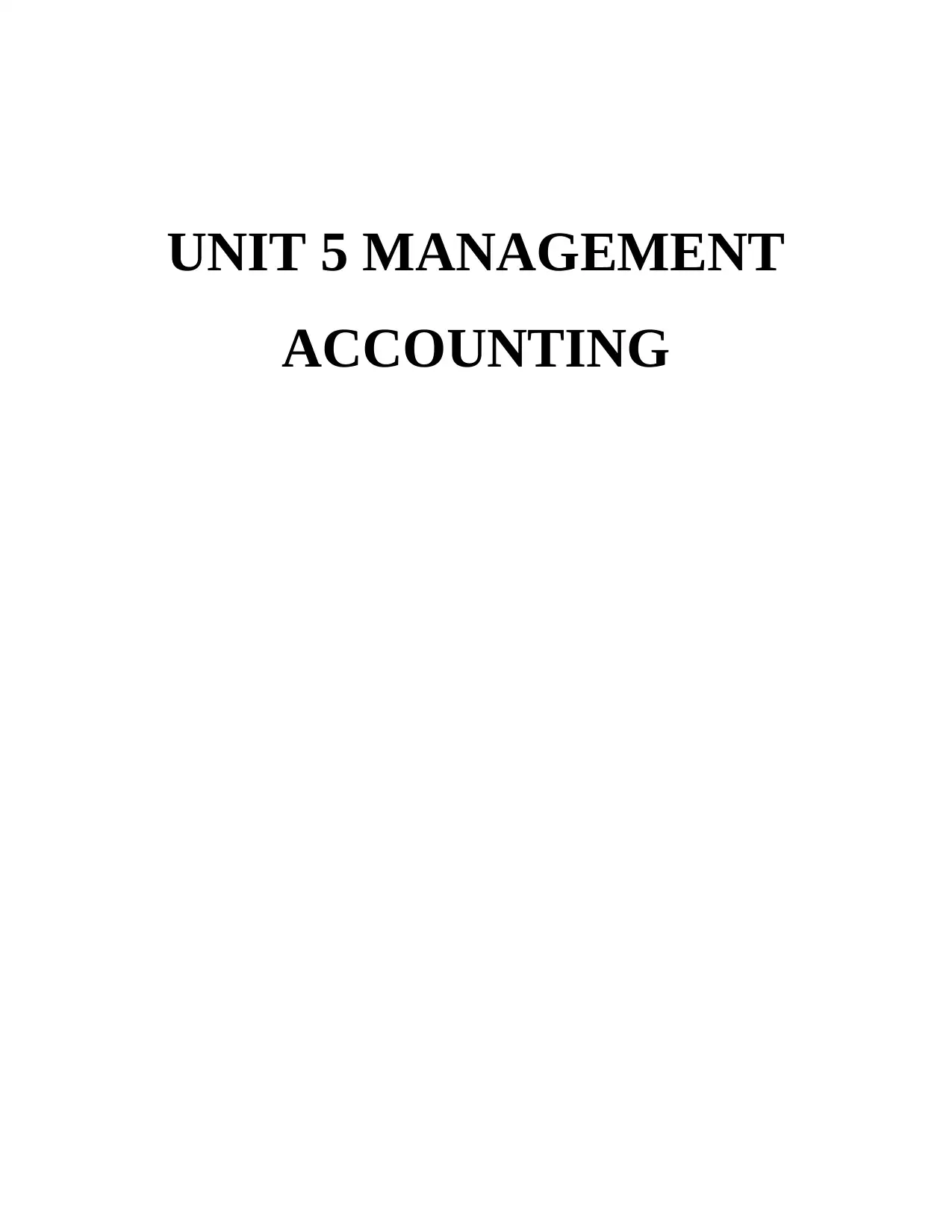
UNIT 5 MANAGEMENT
ACCOUNTING
ACCOUNTING
Paraphrase This Document
Need a fresh take? Get an instant paraphrase of this document with our AI Paraphraser
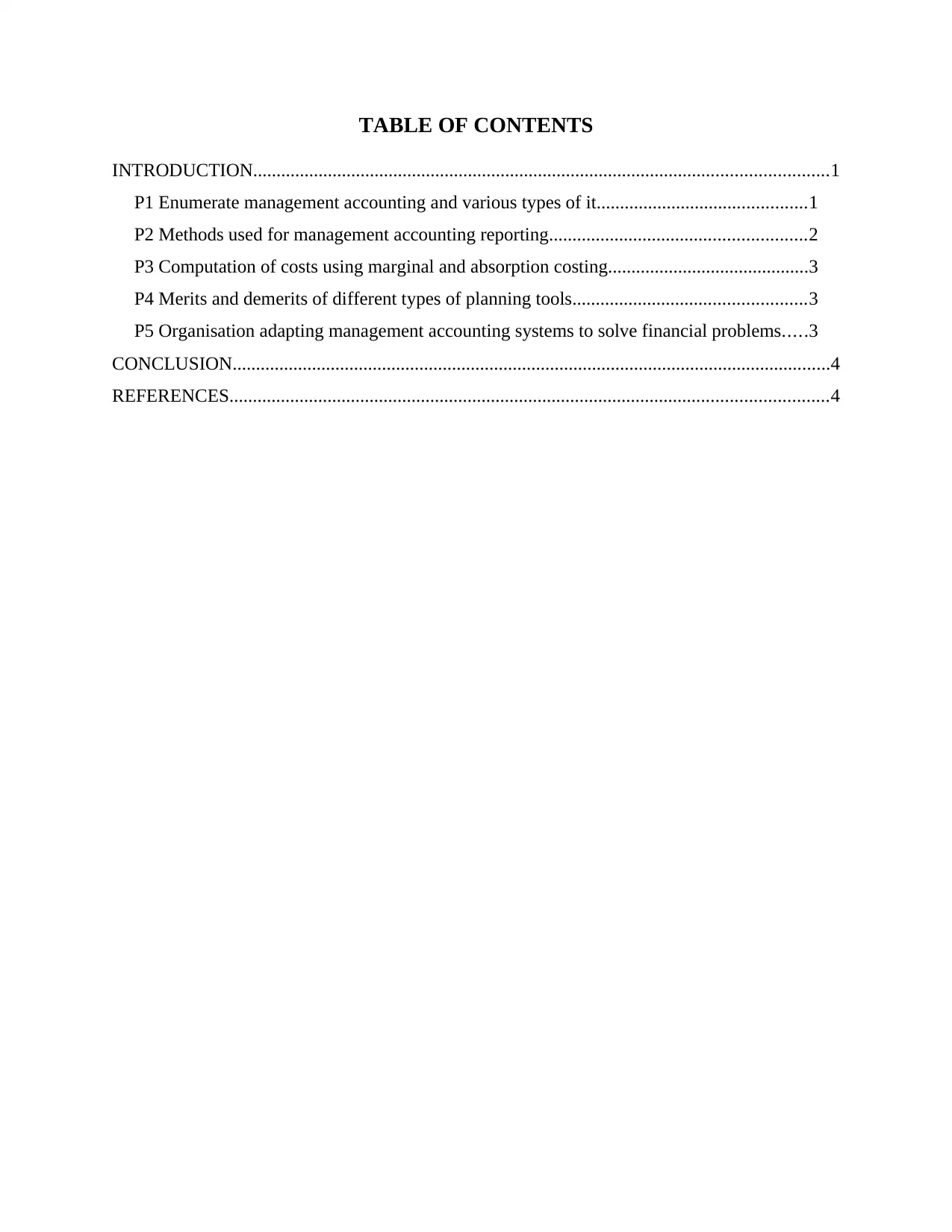
TABLE OF CONTENTS
INTRODUCTION...........................................................................................................................1
P1 Enumerate management accounting and various types of it.............................................1
P2 Methods used for management accounting reporting.......................................................2
P3 Computation of costs using marginal and absorption costing...........................................3
P4 Merits and demerits of different types of planning tools..................................................3
P5 Organisation adapting management accounting systems to solve financial problems.....3
CONCLUSION................................................................................................................................4
REFERENCES................................................................................................................................4
INTRODUCTION...........................................................................................................................1
P1 Enumerate management accounting and various types of it.............................................1
P2 Methods used for management accounting reporting.......................................................2
P3 Computation of costs using marginal and absorption costing...........................................3
P4 Merits and demerits of different types of planning tools..................................................3
P5 Organisation adapting management accounting systems to solve financial problems.....3
CONCLUSION................................................................................................................................4
REFERENCES................................................................................................................................4
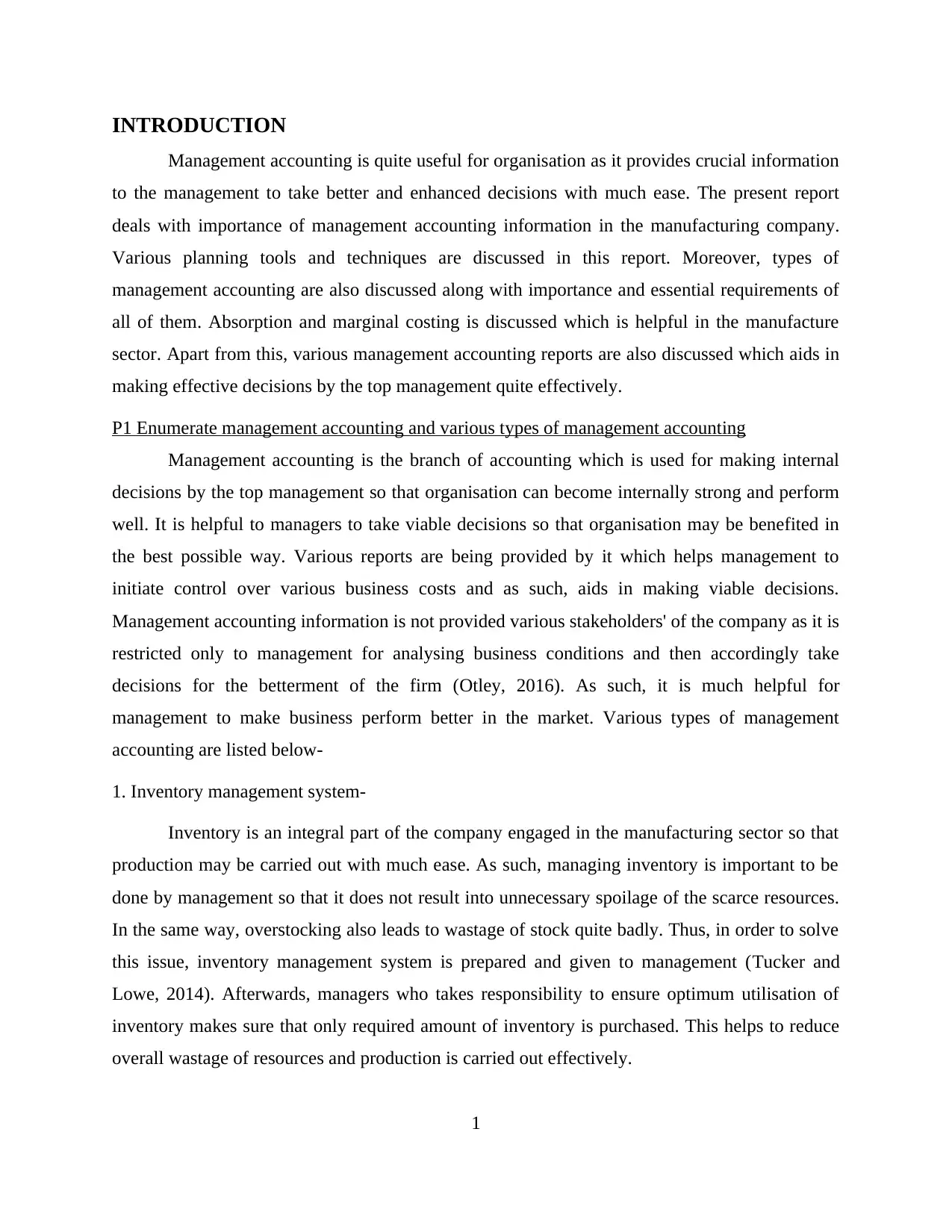
INTRODUCTION
Management accounting is quite useful for organisation as it provides crucial information
to the management to take better and enhanced decisions with much ease. The present report
deals with importance of management accounting information in the manufacturing company.
Various planning tools and techniques are discussed in this report. Moreover, types of
management accounting are also discussed along with importance and essential requirements of
all of them. Absorption and marginal costing is discussed which is helpful in the manufacture
sector. Apart from this, various management accounting reports are also discussed which aids in
making effective decisions by the top management quite effectively.
P1 Enumerate management accounting and various types of management accounting
Management accounting is the branch of accounting which is used for making internal
decisions by the top management so that organisation can become internally strong and perform
well. It is helpful to managers to take viable decisions so that organisation may be benefited in
the best possible way. Various reports are being provided by it which helps management to
initiate control over various business costs and as such, aids in making viable decisions.
Management accounting information is not provided various stakeholders' of the company as it is
restricted only to management for analysing business conditions and then accordingly take
decisions for the betterment of the firm (Otley, 2016). As such, it is much helpful for
management to make business perform better in the market. Various types of management
accounting are listed below-
1. Inventory management system-
Inventory is an integral part of the company engaged in the manufacturing sector so that
production may be carried out with much ease. As such, managing inventory is important to be
done by management so that it does not result into unnecessary spoilage of the scarce resources.
In the same way, overstocking also leads to wastage of stock quite badly. Thus, in order to solve
this issue, inventory management system is prepared and given to management (Tucker and
Lowe, 2014). Afterwards, managers who takes responsibility to ensure optimum utilisation of
inventory makes sure that only required amount of inventory is purchased. This helps to reduce
overall wastage of resources and production is carried out effectively.
1
Management accounting is quite useful for organisation as it provides crucial information
to the management to take better and enhanced decisions with much ease. The present report
deals with importance of management accounting information in the manufacturing company.
Various planning tools and techniques are discussed in this report. Moreover, types of
management accounting are also discussed along with importance and essential requirements of
all of them. Absorption and marginal costing is discussed which is helpful in the manufacture
sector. Apart from this, various management accounting reports are also discussed which aids in
making effective decisions by the top management quite effectively.
P1 Enumerate management accounting and various types of management accounting
Management accounting is the branch of accounting which is used for making internal
decisions by the top management so that organisation can become internally strong and perform
well. It is helpful to managers to take viable decisions so that organisation may be benefited in
the best possible way. Various reports are being provided by it which helps management to
initiate control over various business costs and as such, aids in making viable decisions.
Management accounting information is not provided various stakeholders' of the company as it is
restricted only to management for analysing business conditions and then accordingly take
decisions for the betterment of the firm (Otley, 2016). As such, it is much helpful for
management to make business perform better in the market. Various types of management
accounting are listed below-
1. Inventory management system-
Inventory is an integral part of the company engaged in the manufacturing sector so that
production may be carried out with much ease. As such, managing inventory is important to be
done by management so that it does not result into unnecessary spoilage of the scarce resources.
In the same way, overstocking also leads to wastage of stock quite badly. Thus, in order to solve
this issue, inventory management system is prepared and given to management (Tucker and
Lowe, 2014). Afterwards, managers who takes responsibility to ensure optimum utilisation of
inventory makes sure that only required amount of inventory is purchased. This helps to reduce
overall wastage of resources and production is carried out effectively.
1
⊘ This is a preview!⊘
Do you want full access?
Subscribe today to unlock all pages.

Trusted by 1+ million students worldwide
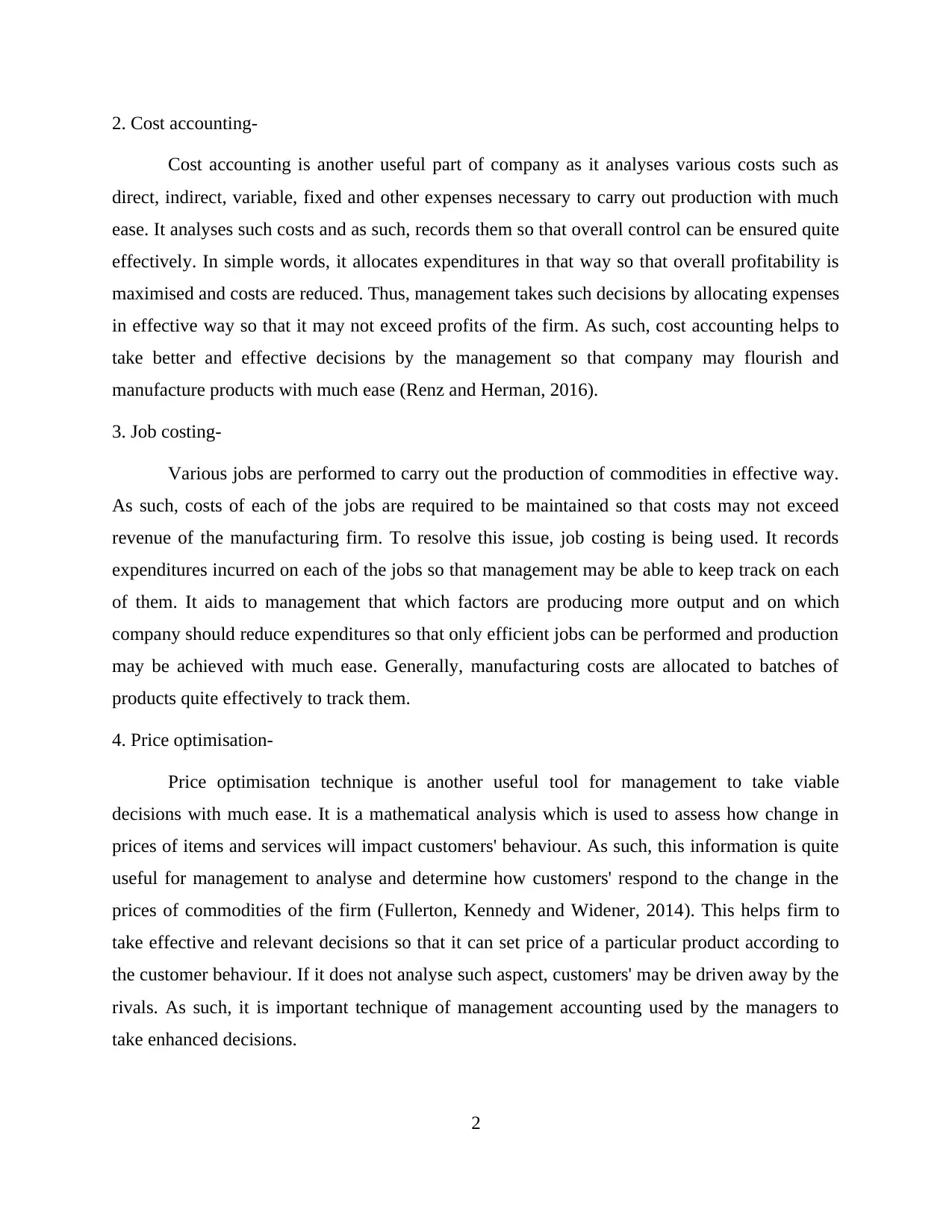
2. Cost accounting-
Cost accounting is another useful part of company as it analyses various costs such as
direct, indirect, variable, fixed and other expenses necessary to carry out production with much
ease. It analyses such costs and as such, records them so that overall control can be ensured quite
effectively. In simple words, it allocates expenditures in that way so that overall profitability is
maximised and costs are reduced. Thus, management takes such decisions by allocating expenses
in effective way so that it may not exceed profits of the firm. As such, cost accounting helps to
take better and effective decisions by the management so that company may flourish and
manufacture products with much ease (Renz and Herman, 2016).
3. Job costing-
Various jobs are performed to carry out the production of commodities in effective way.
As such, costs of each of the jobs are required to be maintained so that costs may not exceed
revenue of the manufacturing firm. To resolve this issue, job costing is being used. It records
expenditures incurred on each of the jobs so that management may be able to keep track on each
of them. It aids to management that which factors are producing more output and on which
company should reduce expenditures so that only efficient jobs can be performed and production
may be achieved with much ease. Generally, manufacturing costs are allocated to batches of
products quite effectively to track them.
4. Price optimisation-
Price optimisation technique is another useful tool for management to take viable
decisions with much ease. It is a mathematical analysis which is used to assess how change in
prices of items and services will impact customers' behaviour. As such, this information is quite
useful for management to analyse and determine how customers' respond to the change in the
prices of commodities of the firm (Fullerton, Kennedy and Widener, 2014). This helps firm to
take effective and relevant decisions so that it can set price of a particular product according to
the customer behaviour. If it does not analyse such aspect, customers' may be driven away by the
rivals. As such, it is important technique of management accounting used by the managers to
take enhanced decisions.
2
Cost accounting is another useful part of company as it analyses various costs such as
direct, indirect, variable, fixed and other expenses necessary to carry out production with much
ease. It analyses such costs and as such, records them so that overall control can be ensured quite
effectively. In simple words, it allocates expenditures in that way so that overall profitability is
maximised and costs are reduced. Thus, management takes such decisions by allocating expenses
in effective way so that it may not exceed profits of the firm. As such, cost accounting helps to
take better and effective decisions by the management so that company may flourish and
manufacture products with much ease (Renz and Herman, 2016).
3. Job costing-
Various jobs are performed to carry out the production of commodities in effective way.
As such, costs of each of the jobs are required to be maintained so that costs may not exceed
revenue of the manufacturing firm. To resolve this issue, job costing is being used. It records
expenditures incurred on each of the jobs so that management may be able to keep track on each
of them. It aids to management that which factors are producing more output and on which
company should reduce expenditures so that only efficient jobs can be performed and production
may be achieved with much ease. Generally, manufacturing costs are allocated to batches of
products quite effectively to track them.
4. Price optimisation-
Price optimisation technique is another useful tool for management to take viable
decisions with much ease. It is a mathematical analysis which is used to assess how change in
prices of items and services will impact customers' behaviour. As such, this information is quite
useful for management to analyse and determine how customers' respond to the change in the
prices of commodities of the firm (Fullerton, Kennedy and Widener, 2014). This helps firm to
take effective and relevant decisions so that it can set price of a particular product according to
the customer behaviour. If it does not analyse such aspect, customers' may be driven away by the
rivals. As such, it is important technique of management accounting used by the managers to
take enhanced decisions.
2
Paraphrase This Document
Need a fresh take? Get an instant paraphrase of this document with our AI Paraphraser
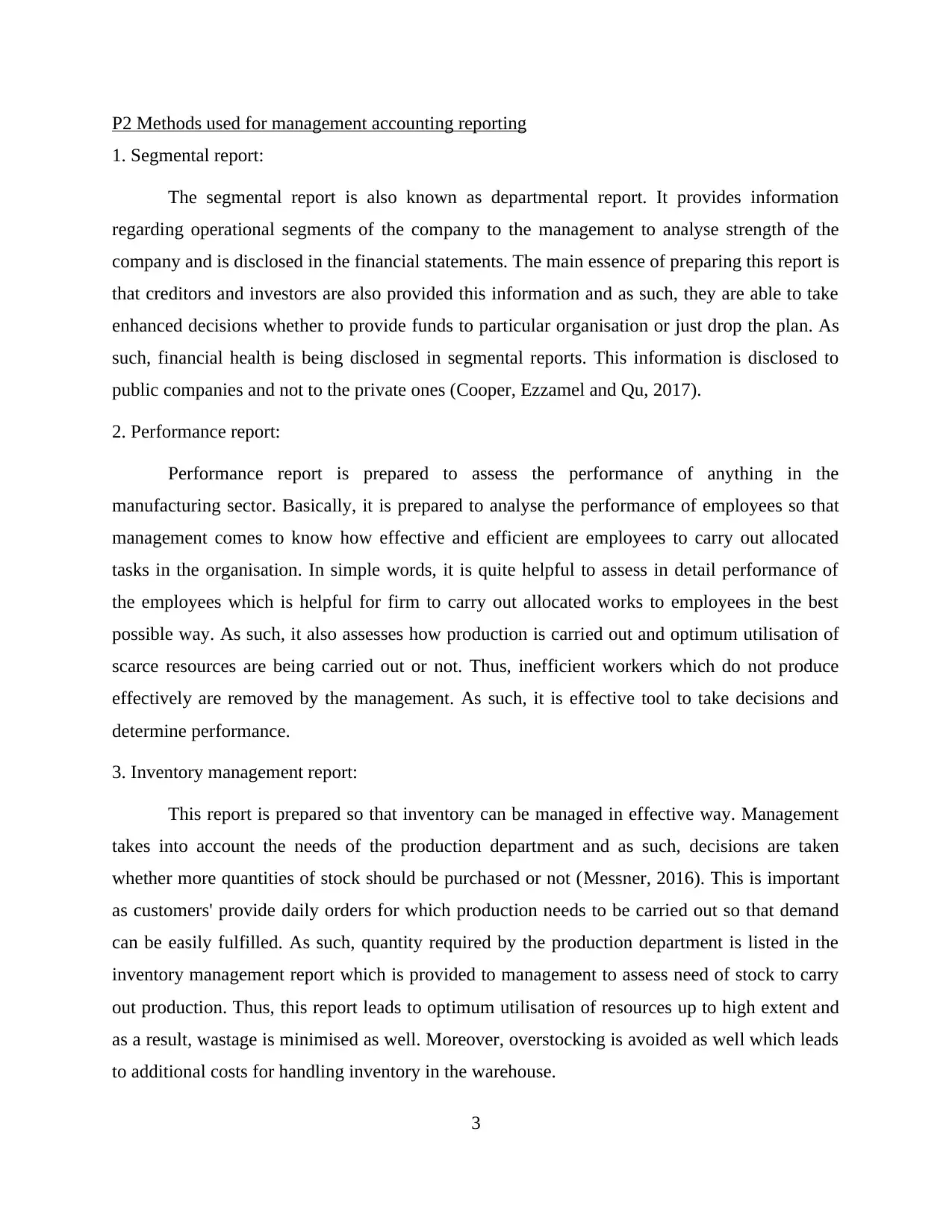
P2 Methods used for management accounting reporting
1. Segmental report:
The segmental report is also known as departmental report. It provides information
regarding operational segments of the company to the management to analyse strength of the
company and is disclosed in the financial statements. The main essence of preparing this report is
that creditors and investors are also provided this information and as such, they are able to take
enhanced decisions whether to provide funds to particular organisation or just drop the plan. As
such, financial health is being disclosed in segmental reports. This information is disclosed to
public companies and not to the private ones (Cooper, Ezzamel and Qu, 2017).
2. Performance report:
Performance report is prepared to assess the performance of anything in the
manufacturing sector. Basically, it is prepared to analyse the performance of employees so that
management comes to know how effective and efficient are employees to carry out allocated
tasks in the organisation. In simple words, it is quite helpful to assess in detail performance of
the employees which is helpful for firm to carry out allocated works to employees in the best
possible way. As such, it also assesses how production is carried out and optimum utilisation of
scarce resources are being carried out or not. Thus, inefficient workers which do not produce
effectively are removed by the management. As such, it is effective tool to take decisions and
determine performance.
3. Inventory management report:
This report is prepared so that inventory can be managed in effective way. Management
takes into account the needs of the production department and as such, decisions are taken
whether more quantities of stock should be purchased or not (Messner, 2016). This is important
as customers' provide daily orders for which production needs to be carried out so that demand
can be easily fulfilled. As such, quantity required by the production department is listed in the
inventory management report which is provided to management to assess need of stock to carry
out production. Thus, this report leads to optimum utilisation of resources up to high extent and
as a result, wastage is minimised as well. Moreover, overstocking is avoided as well which leads
to additional costs for handling inventory in the warehouse.
3
1. Segmental report:
The segmental report is also known as departmental report. It provides information
regarding operational segments of the company to the management to analyse strength of the
company and is disclosed in the financial statements. The main essence of preparing this report is
that creditors and investors are also provided this information and as such, they are able to take
enhanced decisions whether to provide funds to particular organisation or just drop the plan. As
such, financial health is being disclosed in segmental reports. This information is disclosed to
public companies and not to the private ones (Cooper, Ezzamel and Qu, 2017).
2. Performance report:
Performance report is prepared to assess the performance of anything in the
manufacturing sector. Basically, it is prepared to analyse the performance of employees so that
management comes to know how effective and efficient are employees to carry out allocated
tasks in the organisation. In simple words, it is quite helpful to assess in detail performance of
the employees which is helpful for firm to carry out allocated works to employees in the best
possible way. As such, it also assesses how production is carried out and optimum utilisation of
scarce resources are being carried out or not. Thus, inefficient workers which do not produce
effectively are removed by the management. As such, it is effective tool to take decisions and
determine performance.
3. Inventory management report:
This report is prepared so that inventory can be managed in effective way. Management
takes into account the needs of the production department and as such, decisions are taken
whether more quantities of stock should be purchased or not (Messner, 2016). This is important
as customers' provide daily orders for which production needs to be carried out so that demand
can be easily fulfilled. As such, quantity required by the production department is listed in the
inventory management report which is provided to management to assess need of stock to carry
out production. Thus, this report leads to optimum utilisation of resources up to high extent and
as a result, wastage is minimised as well. Moreover, overstocking is avoided as well which leads
to additional costs for handling inventory in the warehouse.
3
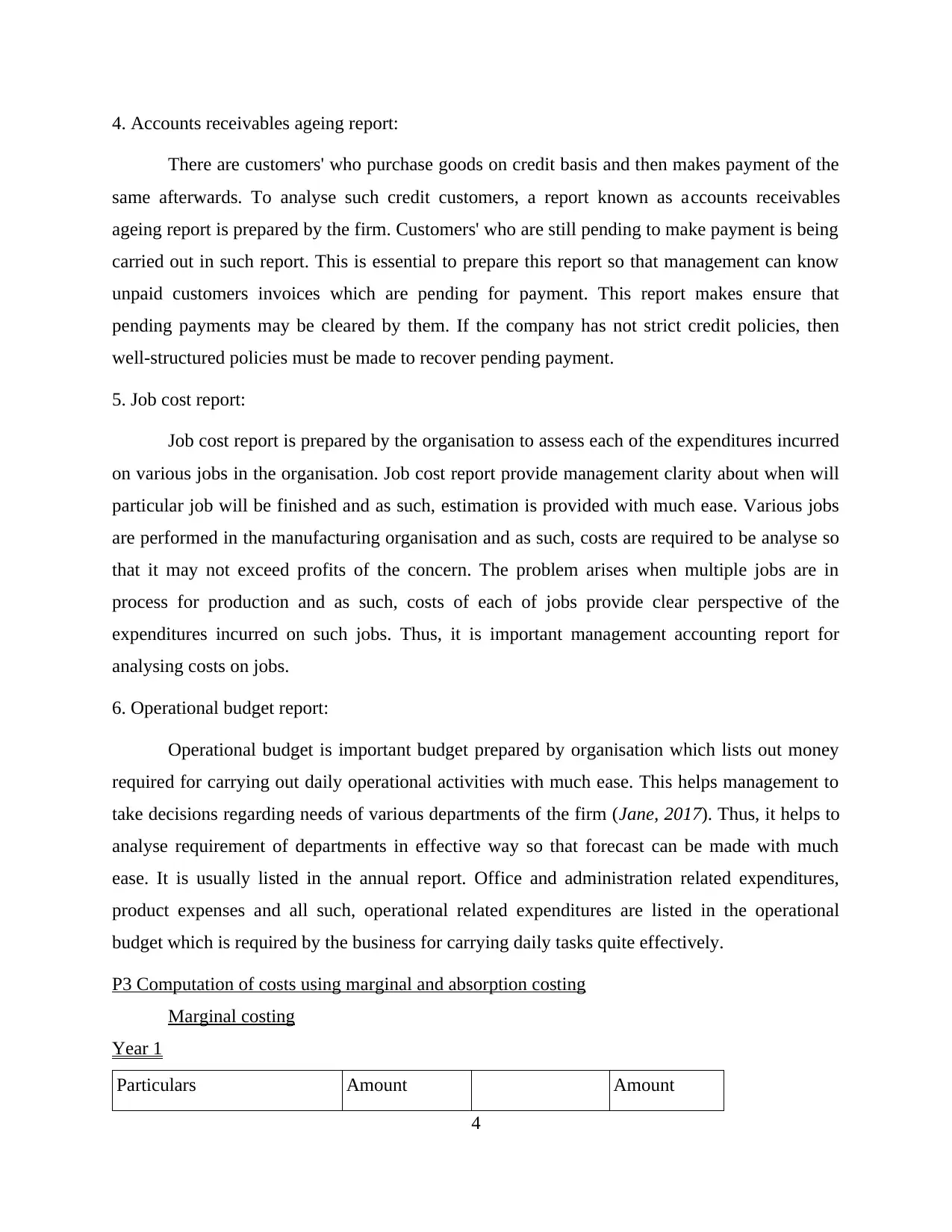
4. Accounts receivables ageing report:
There are customers' who purchase goods on credit basis and then makes payment of the
same afterwards. To analyse such credit customers, a report known as accounts receivables
ageing report is prepared by the firm. Customers' who are still pending to make payment is being
carried out in such report. This is essential to prepare this report so that management can know
unpaid customers invoices which are pending for payment. This report makes ensure that
pending payments may be cleared by them. If the company has not strict credit policies, then
well-structured policies must be made to recover pending payment.
5. Job cost report:
Job cost report is prepared by the organisation to assess each of the expenditures incurred
on various jobs in the organisation. Job cost report provide management clarity about when will
particular job will be finished and as such, estimation is provided with much ease. Various jobs
are performed in the manufacturing organisation and as such, costs are required to be analyse so
that it may not exceed profits of the concern. The problem arises when multiple jobs are in
process for production and as such, costs of each of jobs provide clear perspective of the
expenditures incurred on such jobs. Thus, it is important management accounting report for
analysing costs on jobs.
6. Operational budget report:
Operational budget is important budget prepared by organisation which lists out money
required for carrying out daily operational activities with much ease. This helps management to
take decisions regarding needs of various departments of the firm (Jane, 2017). Thus, it helps to
analyse requirement of departments in effective way so that forecast can be made with much
ease. It is usually listed in the annual report. Office and administration related expenditures,
product expenses and all such, operational related expenditures are listed in the operational
budget which is required by the business for carrying daily tasks quite effectively.
P3 Computation of costs using marginal and absorption costing
Marginal costing
Year 1
Particulars Amount Amount
4
There are customers' who purchase goods on credit basis and then makes payment of the
same afterwards. To analyse such credit customers, a report known as accounts receivables
ageing report is prepared by the firm. Customers' who are still pending to make payment is being
carried out in such report. This is essential to prepare this report so that management can know
unpaid customers invoices which are pending for payment. This report makes ensure that
pending payments may be cleared by them. If the company has not strict credit policies, then
well-structured policies must be made to recover pending payment.
5. Job cost report:
Job cost report is prepared by the organisation to assess each of the expenditures incurred
on various jobs in the organisation. Job cost report provide management clarity about when will
particular job will be finished and as such, estimation is provided with much ease. Various jobs
are performed in the manufacturing organisation and as such, costs are required to be analyse so
that it may not exceed profits of the concern. The problem arises when multiple jobs are in
process for production and as such, costs of each of jobs provide clear perspective of the
expenditures incurred on such jobs. Thus, it is important management accounting report for
analysing costs on jobs.
6. Operational budget report:
Operational budget is important budget prepared by organisation which lists out money
required for carrying out daily operational activities with much ease. This helps management to
take decisions regarding needs of various departments of the firm (Jane, 2017). Thus, it helps to
analyse requirement of departments in effective way so that forecast can be made with much
ease. It is usually listed in the annual report. Office and administration related expenditures,
product expenses and all such, operational related expenditures are listed in the operational
budget which is required by the business for carrying daily tasks quite effectively.
P3 Computation of costs using marginal and absorption costing
Marginal costing
Year 1
Particulars Amount Amount
4
⊘ This is a preview!⊘
Do you want full access?
Subscribe today to unlock all pages.

Trusted by 1+ million students worldwide
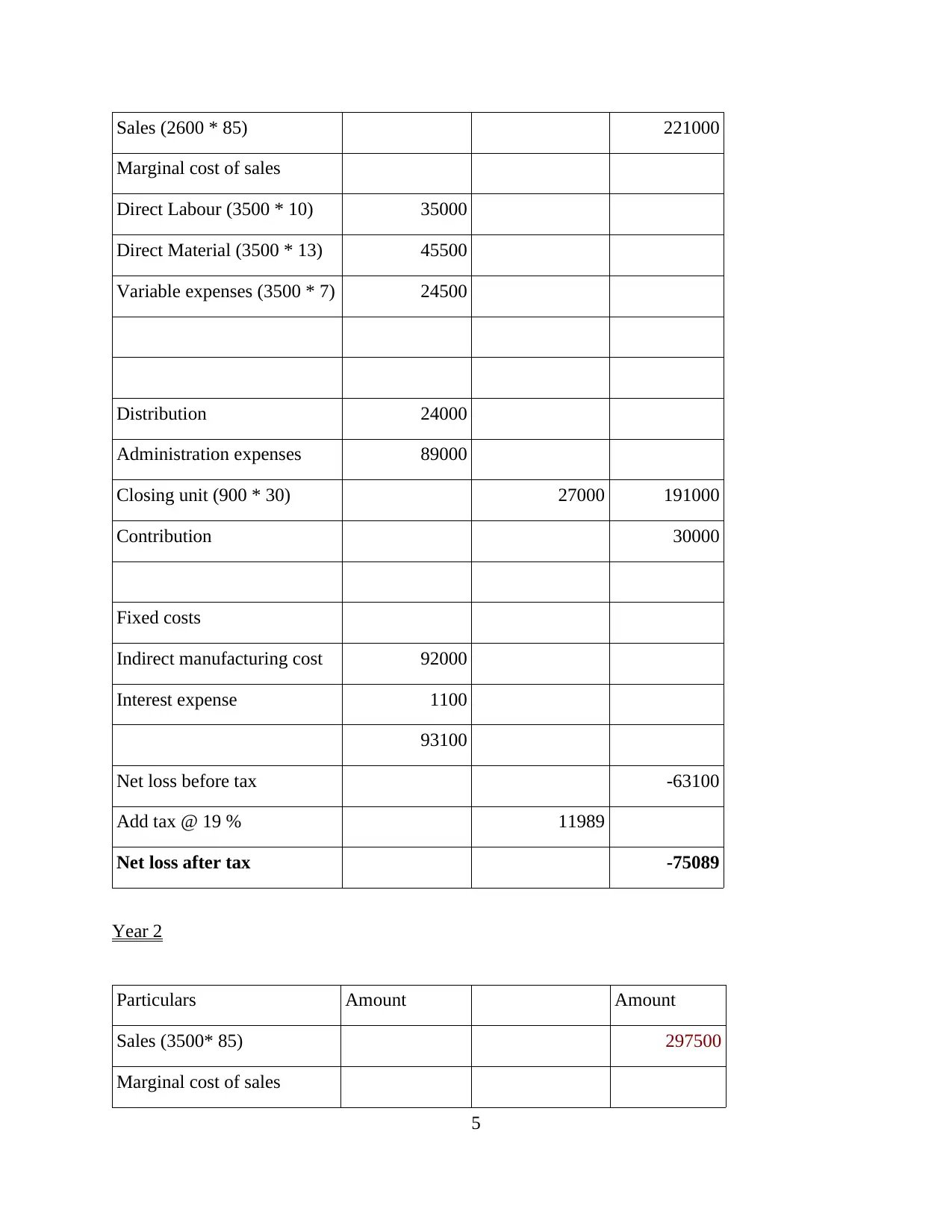
Sales (2600 * 85) 221000
Marginal cost of sales
Direct Labour (3500 * 10) 35000
Direct Material (3500 * 13) 45500
Variable expenses (3500 * 7) 24500
Distribution 24000
Administration expenses 89000
Closing unit (900 * 30) 27000 191000
Contribution 30000
Fixed costs
Indirect manufacturing cost 92000
Interest expense 1100
93100
Net loss before tax -63100
Add tax @ 19 % 11989
Net loss after tax -75089
Year 2
Particulars Amount Amount
Sales (3500* 85) 297500
Marginal cost of sales
5
Marginal cost of sales
Direct Labour (3500 * 10) 35000
Direct Material (3500 * 13) 45500
Variable expenses (3500 * 7) 24500
Distribution 24000
Administration expenses 89000
Closing unit (900 * 30) 27000 191000
Contribution 30000
Fixed costs
Indirect manufacturing cost 92000
Interest expense 1100
93100
Net loss before tax -63100
Add tax @ 19 % 11989
Net loss after tax -75089
Year 2
Particulars Amount Amount
Sales (3500* 85) 297500
Marginal cost of sales
5
Paraphrase This Document
Need a fresh take? Get an instant paraphrase of this document with our AI Paraphraser
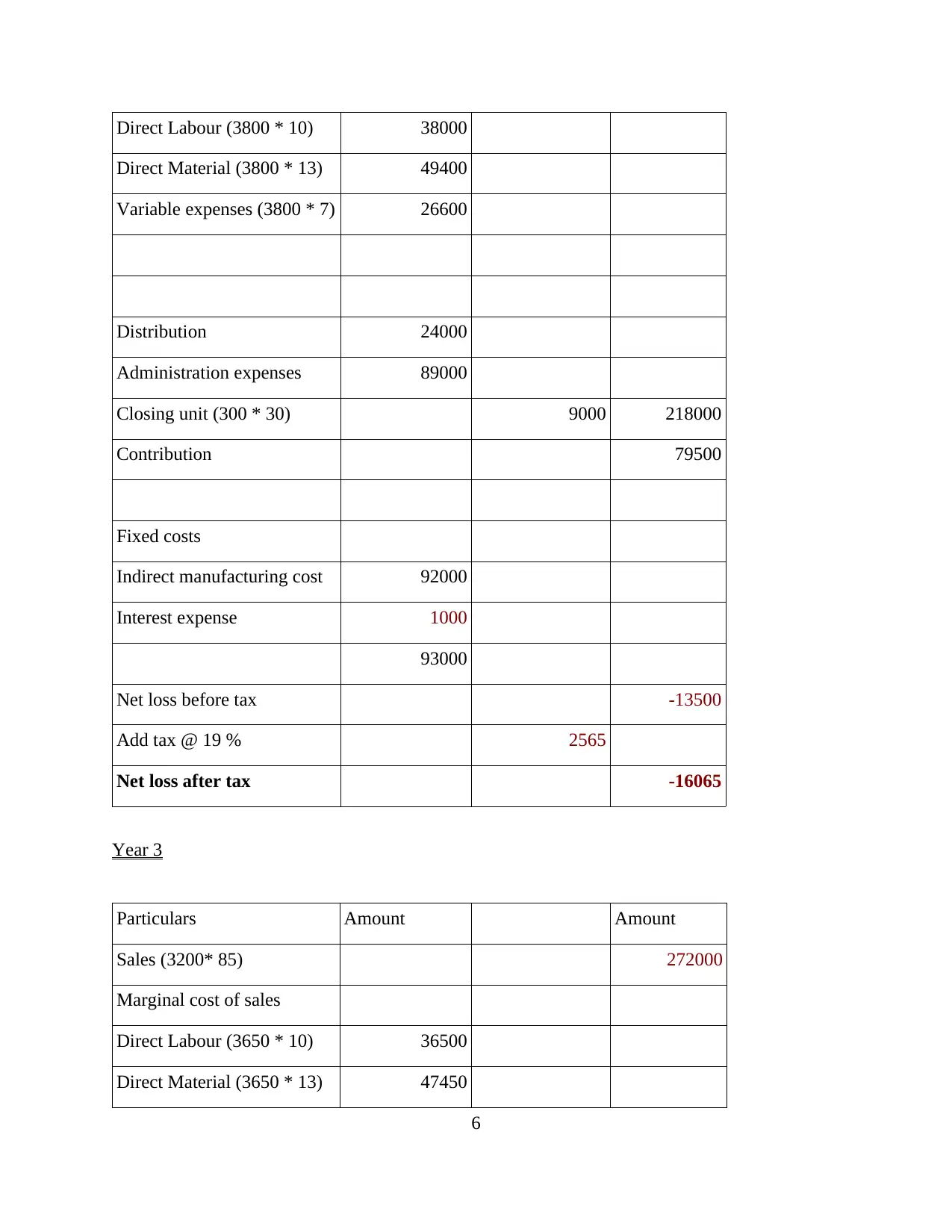
Direct Labour (3800 * 10) 38000
Direct Material (3800 * 13) 49400
Variable expenses (3800 * 7) 26600
Distribution 24000
Administration expenses 89000
Closing unit (300 * 30) 9000 218000
Contribution 79500
Fixed costs
Indirect manufacturing cost 92000
Interest expense 1000
93000
Net loss before tax -13500
Add tax @ 19 % 2565
Net loss after tax -16065
Year 3
Particulars Amount Amount
Sales (3200* 85) 272000
Marginal cost of sales
Direct Labour (3650 * 10) 36500
Direct Material (3650 * 13) 47450
6
Direct Material (3800 * 13) 49400
Variable expenses (3800 * 7) 26600
Distribution 24000
Administration expenses 89000
Closing unit (300 * 30) 9000 218000
Contribution 79500
Fixed costs
Indirect manufacturing cost 92000
Interest expense 1000
93000
Net loss before tax -13500
Add tax @ 19 % 2565
Net loss after tax -16065
Year 3
Particulars Amount Amount
Sales (3200* 85) 272000
Marginal cost of sales
Direct Labour (3650 * 10) 36500
Direct Material (3650 * 13) 47450
6
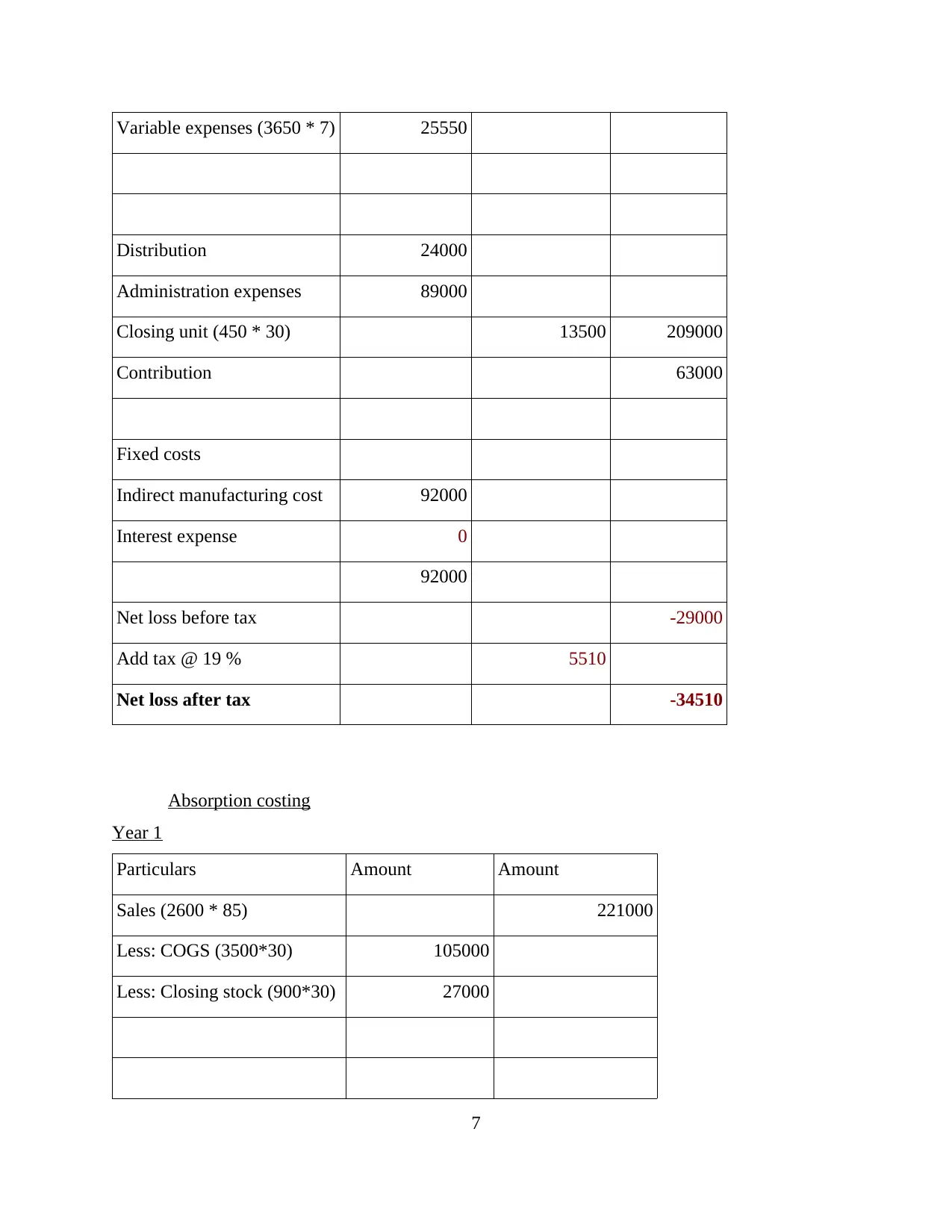
Variable expenses (3650 * 7) 25550
Distribution 24000
Administration expenses 89000
Closing unit (450 * 30) 13500 209000
Contribution 63000
Fixed costs
Indirect manufacturing cost 92000
Interest expense 0
92000
Net loss before tax -29000
Add tax @ 19 % 5510
Net loss after tax -34510
Absorption costing
Year 1
Particulars Amount Amount
Sales (2600 * 85) 221000
Less: COGS (3500*30) 105000
Less: Closing stock (900*30) 27000
7
Distribution 24000
Administration expenses 89000
Closing unit (450 * 30) 13500 209000
Contribution 63000
Fixed costs
Indirect manufacturing cost 92000
Interest expense 0
92000
Net loss before tax -29000
Add tax @ 19 % 5510
Net loss after tax -34510
Absorption costing
Year 1
Particulars Amount Amount
Sales (2600 * 85) 221000
Less: COGS (3500*30) 105000
Less: Closing stock (900*30) 27000
7
⊘ This is a preview!⊘
Do you want full access?
Subscribe today to unlock all pages.

Trusted by 1+ million students worldwide
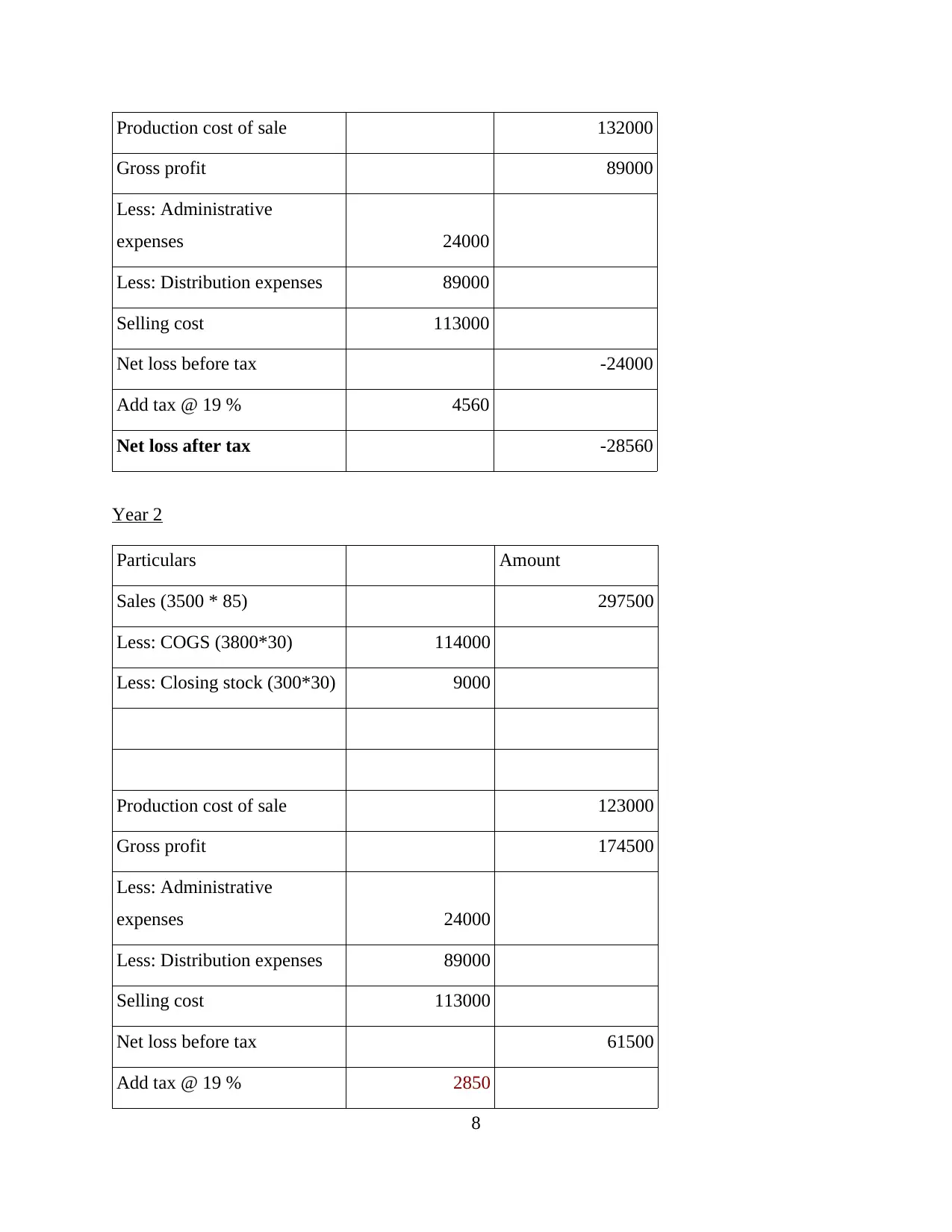
Production cost of sale 132000
Gross profit 89000
Less: Administrative
expenses 24000
Less: Distribution expenses 89000
Selling cost 113000
Net loss before tax -24000
Add tax @ 19 % 4560
Net loss after tax -28560
Year 2
Particulars Amount
Sales (3500 * 85) 297500
Less: COGS (3800*30) 114000
Less: Closing stock (300*30) 9000
Production cost of sale 123000
Gross profit 174500
Less: Administrative
expenses 24000
Less: Distribution expenses 89000
Selling cost 113000
Net loss before tax 61500
Add tax @ 19 % 2850
8
Gross profit 89000
Less: Administrative
expenses 24000
Less: Distribution expenses 89000
Selling cost 113000
Net loss before tax -24000
Add tax @ 19 % 4560
Net loss after tax -28560
Year 2
Particulars Amount
Sales (3500 * 85) 297500
Less: COGS (3800*30) 114000
Less: Closing stock (300*30) 9000
Production cost of sale 123000
Gross profit 174500
Less: Administrative
expenses 24000
Less: Distribution expenses 89000
Selling cost 113000
Net loss before tax 61500
Add tax @ 19 % 2850
8
Paraphrase This Document
Need a fresh take? Get an instant paraphrase of this document with our AI Paraphraser
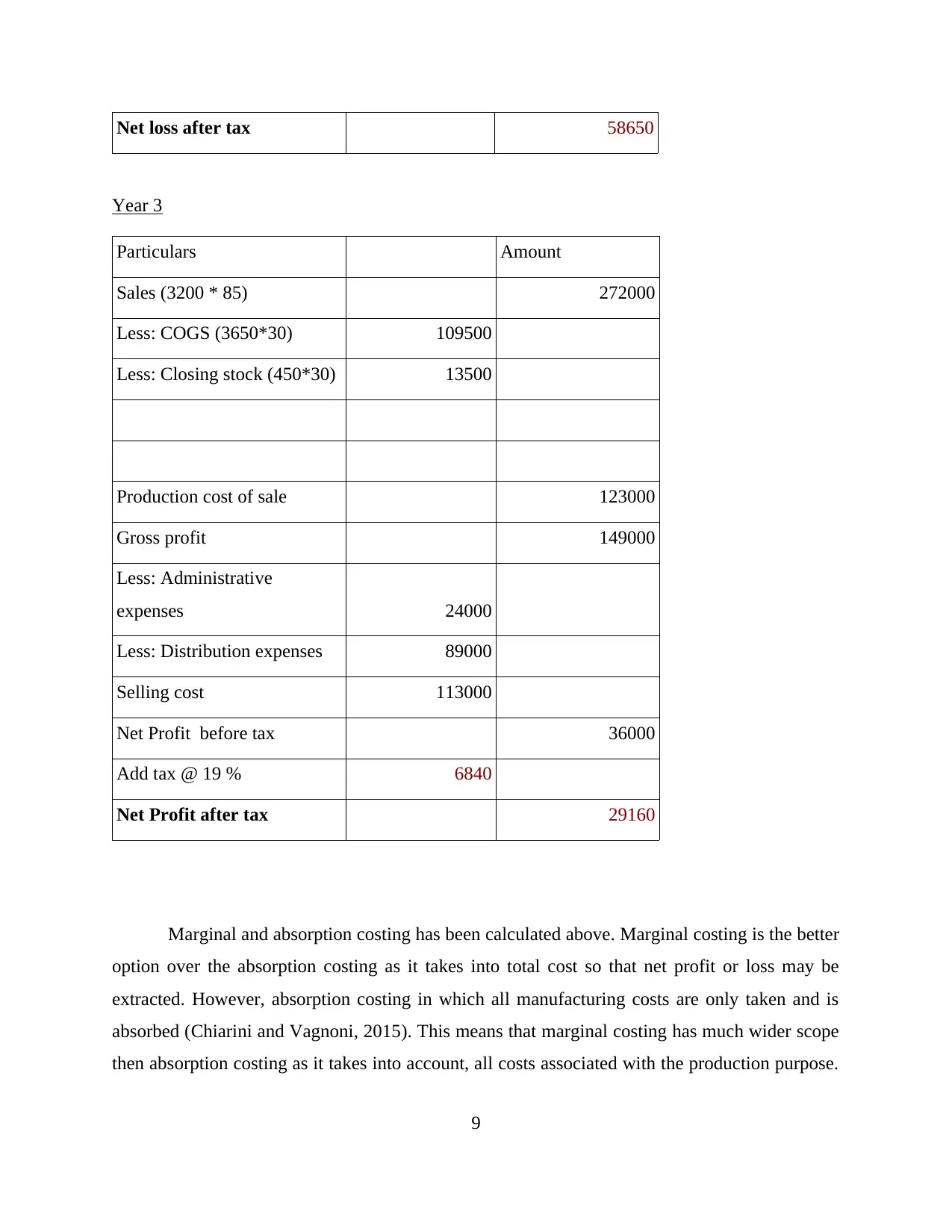
Net loss after tax 58650
Year 3
Particulars Amount
Sales (3200 * 85) 272000
Less: COGS (3650*30) 109500
Less: Closing stock (450*30) 13500
Production cost of sale 123000
Gross profit 149000
Less: Administrative
expenses 24000
Less: Distribution expenses 89000
Selling cost 113000
Net Profit before tax 36000
Add tax @ 19 % 6840
Net Profit after tax 29160
Marginal and absorption costing has been calculated above. Marginal costing is the better
option over the absorption costing as it takes into total cost so that net profit or loss may be
extracted. However, absorption costing in which all manufacturing costs are only taken and is
absorbed (Chiarini and Vagnoni, 2015). This means that marginal costing has much wider scope
then absorption costing as it takes into account, all costs associated with the production purpose.
9
Year 3
Particulars Amount
Sales (3200 * 85) 272000
Less: COGS (3650*30) 109500
Less: Closing stock (450*30) 13500
Production cost of sale 123000
Gross profit 149000
Less: Administrative
expenses 24000
Less: Distribution expenses 89000
Selling cost 113000
Net Profit before tax 36000
Add tax @ 19 % 6840
Net Profit after tax 29160
Marginal and absorption costing has been calculated above. Marginal costing is the better
option over the absorption costing as it takes into total cost so that net profit or loss may be
extracted. However, absorption costing in which all manufacturing costs are only taken and is
absorbed (Chiarini and Vagnoni, 2015). This means that marginal costing has much wider scope
then absorption costing as it takes into account, all costs associated with the production purpose.
9
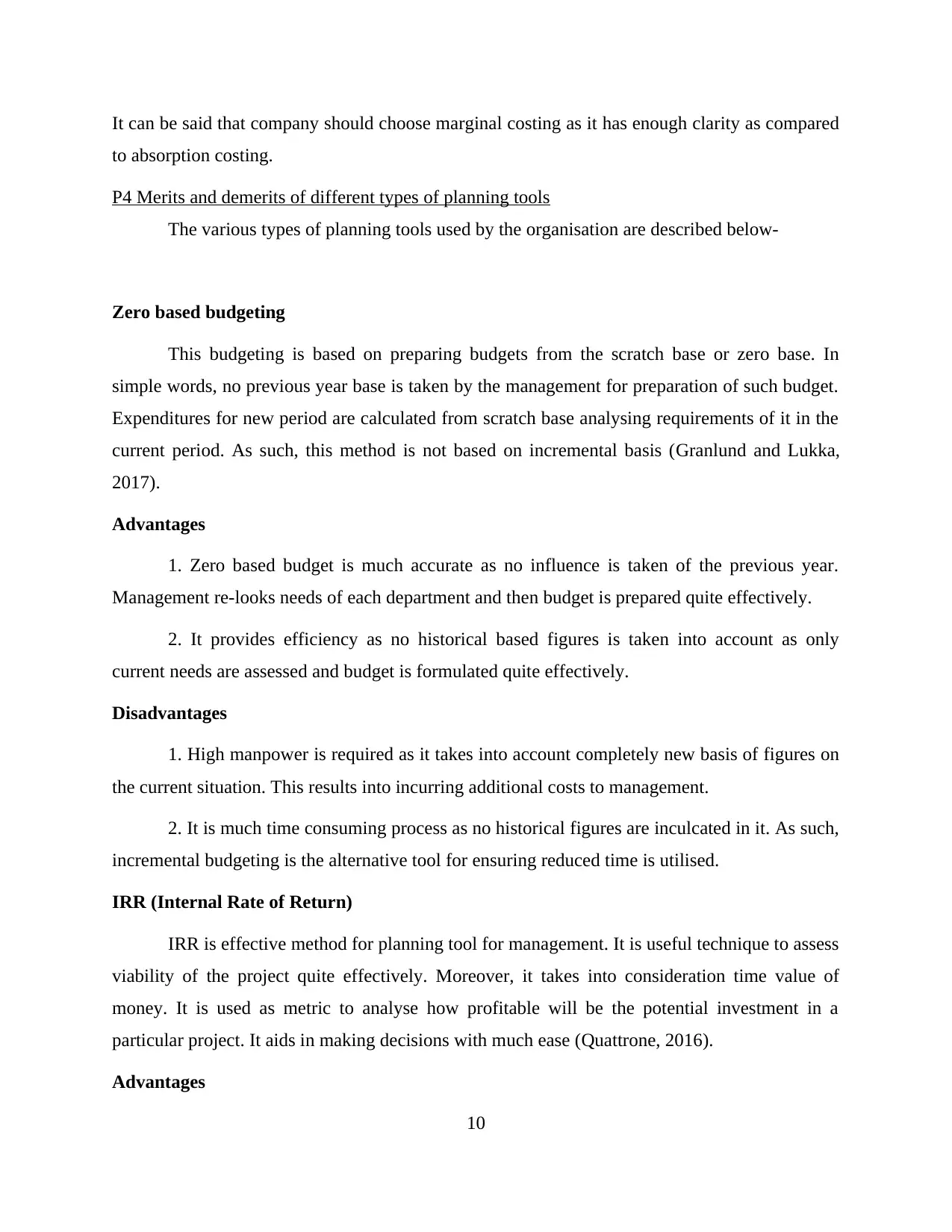
It can be said that company should choose marginal costing as it has enough clarity as compared
to absorption costing.
P4 Merits and demerits of different types of planning tools
The various types of planning tools used by the organisation are described below-
Zero based budgeting
This budgeting is based on preparing budgets from the scratch base or zero base. In
simple words, no previous year base is taken by the management for preparation of such budget.
Expenditures for new period are calculated from scratch base analysing requirements of it in the
current period. As such, this method is not based on incremental basis (Granlund and Lukka,
2017).
Advantages
1. Zero based budget is much accurate as no influence is taken of the previous year.
Management re-looks needs of each department and then budget is prepared quite effectively.
2. It provides efficiency as no historical based figures is taken into account as only
current needs are assessed and budget is formulated quite effectively.
Disadvantages
1. High manpower is required as it takes into account completely new basis of figures on
the current situation. This results into incurring additional costs to management.
2. It is much time consuming process as no historical figures are inculcated in it. As such,
incremental budgeting is the alternative tool for ensuring reduced time is utilised.
IRR (Internal Rate of Return)
IRR is effective method for planning tool for management. It is useful technique to assess
viability of the project quite effectively. Moreover, it takes into consideration time value of
money. It is used as metric to analyse how profitable will be the potential investment in a
particular project. It aids in making decisions with much ease (Quattrone, 2016).
Advantages
10
to absorption costing.
P4 Merits and demerits of different types of planning tools
The various types of planning tools used by the organisation are described below-
Zero based budgeting
This budgeting is based on preparing budgets from the scratch base or zero base. In
simple words, no previous year base is taken by the management for preparation of such budget.
Expenditures for new period are calculated from scratch base analysing requirements of it in the
current period. As such, this method is not based on incremental basis (Granlund and Lukka,
2017).
Advantages
1. Zero based budget is much accurate as no influence is taken of the previous year.
Management re-looks needs of each department and then budget is prepared quite effectively.
2. It provides efficiency as no historical based figures is taken into account as only
current needs are assessed and budget is formulated quite effectively.
Disadvantages
1. High manpower is required as it takes into account completely new basis of figures on
the current situation. This results into incurring additional costs to management.
2. It is much time consuming process as no historical figures are inculcated in it. As such,
incremental budgeting is the alternative tool for ensuring reduced time is utilised.
IRR (Internal Rate of Return)
IRR is effective method for planning tool for management. It is useful technique to assess
viability of the project quite effectively. Moreover, it takes into consideration time value of
money. It is used as metric to analyse how profitable will be the potential investment in a
particular project. It aids in making decisions with much ease (Quattrone, 2016).
Advantages
10
⊘ This is a preview!⊘
Do you want full access?
Subscribe today to unlock all pages.

Trusted by 1+ million students worldwide
1 out of 17
Related Documents
Your All-in-One AI-Powered Toolkit for Academic Success.
+13062052269
info@desklib.com
Available 24*7 on WhatsApp / Email
![[object Object]](/_next/static/media/star-bottom.7253800d.svg)
Unlock your academic potential
Copyright © 2020–2025 A2Z Services. All Rights Reserved. Developed and managed by ZUCOL.





